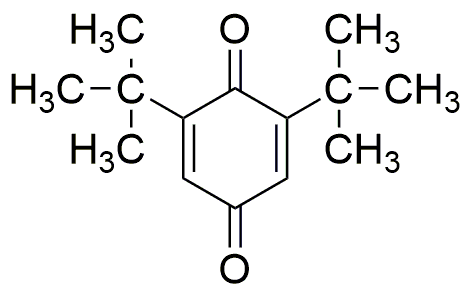2,6-Di-tert-butyl-1,4-benzoquinone is widely utilized in research focused on:
- Antioxidant Applications: This compound is effective in preventing oxidative damage in various materials, making it valuable in the food and cosmetic industries for preserving product integrity.
- Polymer Stabilization: It is used as a stabilizer in polymers, enhancing their thermal and oxidative stability, which is crucial for industries such as plastics and rubber manufacturing.
- Pharmaceutical Development: In medicinal chemistry, it serves as a precursor for synthesizing various pharmaceutical compounds, particularly those targeting oxidative stress-related diseases.
- Research in Biochemistry: The compound is utilized in studies investigating redox reactions and electron transfer processes, providing insights into cellular mechanisms and potential therapeutic targets.
- Environmental Applications: It can be employed in the development of sensors for detecting pollutants, contributing to environmental monitoring and protection efforts.
General Information
Properties
Safety and Regulations
Applications
2,6-Di-tert-butyl-1,4-benzoquinone is widely utilized in research focused on:
- Antioxidant Applications: This compound is effective in preventing oxidative damage in various materials, making it valuable in the food and cosmetic industries for preserving product integrity.
- Polymer Stabilization: It is used as a stabilizer in polymers, enhancing their thermal and oxidative stability, which is crucial for industries such as plastics and rubber manufacturing.
- Pharmaceutical Development: In medicinal chemistry, it serves as a precursor for synthesizing various pharmaceutical compounds, particularly those targeting oxidative stress-related diseases.
- Research in Biochemistry: The compound is utilized in studies investigating redox reactions and electron transfer processes, providing insights into cellular mechanisms and potential therapeutic targets.
- Environmental Applications: It can be employed in the development of sensors for detecting pollutants, contributing to environmental monitoring and protection efforts.
Documents
Safety Data Sheets (SDS)
The SDS provides comprehensive safety information on handling, storage, and disposal of the product.
Product Specification (PS)
The PS provides a comprehensive breakdown of the product’s properties, including chemical composition, physical state, purity, and storage requirements. It also details acceptable quality ranges and the product's intended applications.
Certificates of Analysis (COA)
Search for Certificates of Analysis (COA) by entering the products Lot Number. Lot and Batch Numbers can be found on a product’s label following the words ‘Lot’ or ‘Batch’.
*Catalog Number
*Lot Number
Certificates Of Origin (COO)
This COO confirms the country where the product was manufactured, and also details the materials and components used in it and whether it is derived from natural, synthetic, or other specific sources. This certificate may be required for customs, trade, and regulatory compliance.
*Catalog Number
*Lot Number
Safety Data Sheets (SDS)
The SDS provides comprehensive safety information on handling, storage, and disposal of the product.
DownloadProduct Specification (PS)
The PS provides a comprehensive breakdown of the product’s properties, including chemical composition, physical state, purity, and storage requirements. It also details acceptable quality ranges and the product's intended applications.
DownloadCertificates of Analysis (COA)
Search for Certificates of Analysis (COA) by entering the products Lot Number. Lot and Batch Numbers can be found on a product’s label following the words ‘Lot’ or ‘Batch’.
*Catalog Number
*Lot Number
Certificates Of Origin (COO)
This COO confirms the country where the product was manufactured, and also details the materials and components used in it and whether it is derived from natural, synthetic, or other specific sources. This certificate may be required for customs, trade, and regulatory compliance.


